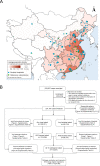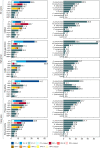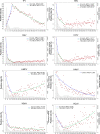Etiological and epidemiological features of acute respiratory infections in China
- PMID: 34408158
- PMCID: PMC8373954
- DOI: 10.1038/s41467-021-25120-6
Etiological and epidemiological features of acute respiratory infections in China
Abstract
Nationwide prospective surveillance of all-age patients with acute respiratory infections was conducted in China between 2009‒2019. Here we report the etiological and epidemiological features of the 231,107 eligible patients enrolled in this analysis. Children <5 years old and school-age children have the highest viral positivity rate (46.9%) and bacterial positivity rate (30.9%). Influenza virus, respiratory syncytial virus and human rhinovirus are the three leading viral pathogens with proportions of 28.5%, 16.8% and 16.7%, and Streptococcus pneumoniae, Mycoplasma pneumoniae and Klebsiella pneumoniae are the three leading bacterial pathogens (29.9%, 18.6% and 15.8%). Negative interactions between viruses and positive interactions between viral and bacterial pathogens are common. A Join-Point analysis reveals the age-specific positivity rate and how this varied for individual pathogens. These data indicate that differential priorities for diagnosis, prevention and control should be highlighted in terms of acute respiratory tract infection patients' demography, geographic locations and season of illness in China.
© 2021. The Author(s).
Conflict of interest statement
The authors declare no competing interests.
Figures




References
-
- World Health Organization. Global Health Estimates 2016: deaths by cause, age, sex, by country and by region, 2000‒2016 (2018); http://www.who.int/healthinfo/global_burden_disease/estimates/en/index1....
Publication types
MeSH terms
LinkOut - more resources
Full Text Sources
Medical

